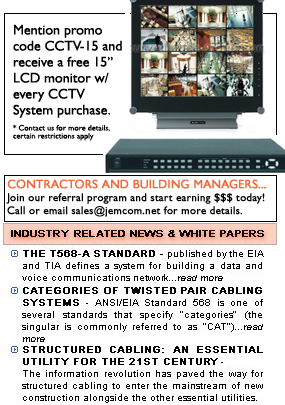

THE T568-A STANDARD:
The T568-A standard published by the Electronic Industry Association and Telecommunications Industry Association defines a system for building a data and voice communications network in an office environment that will have a lifespan of at least ten years and support networking products made by multiple vendors. The most commonly used structured cabling system uses unshielded twisted pair cabling wired according EIA/TIA-568A standard. In this kind of wiring the rooms are wired in star-topology from the central wiring room. The most commonly used cable type nowadays is CAT 5e unshielded twister pair cable terminated to RJ-45 (ISO 8877 / IEC 60603-7 8-position modular connectors) connectors (four twisted pairs per cable). This kind of cabling can be used to carry telephone signals (both analogue and digital) as well as data communication needs. EIA/TIA-568A cabling standard is for USA markets. EIA/TIA-568A standard gives two options for cable color coding TIA568A and TIA568B. EIA/TIA 568A and 568B are two wiring methods used to indicate which colors are assigned to which pin of the modular jack. From those color coding the most commonly used one is TIA568B. The T568-A standard standard also defines the categories used to grade UTP cable. These categories have become the industry standard for UTP cable performance and are widely used by many manufacturers.
Here are some common cable types you might encounter in telecommunication installations:
-
100 ohm unshielded twisted pair: modern structured cabling systems (CAT 3, CAT 4, CAT 5, CAT 6) used to carry telephone signal and networking signals within buildings
-
120 ohm unshielded twisted pair: Some older telecommunication cables on the field (quite typical value for line from central office to house)
-
150 ohm shielded twisted pair: Those are generally used for some older networking systems like IBM cabling system used for Token Ring network. 150 ohm shielded twisted pair cable is also sometimes used to carry balanced audio signals and automation systems signals (generally applications which need shielded twisted pair wiring.
-
75 ohm coaxial cable: video interconnection, CCTV, common antenna wiring, cable TV, some telecommunication signals
-
50 ohm coaxial cable: antenna wiring for radio transmitters, WLAN cards, cellular phone base stations etc.
For twisted pair data applications there are three possible nominal impedance levels: 100 ohms, 120 ohms and 150 ohms. 100 ohm cables are having the predominant market share and therefore the development of hardware and software is mainly focusing on 100 ohm systems. If you do not have any specific reasons to choose otherwise, use 100 ohms cable for data installation. The typical cable copper wire thickness used here is 24 AWG. The most common jacketed cable consists of four tightly twisted pairs of #24 gauge insulated copper conductors. It is extensively used in commercial applications and is finding its way into new homes to meet rising consumer demand

HOME | SERVICES | CONSULT REQUEST | SUPPORT | CONTACT | PARTNERS | WHITE PAPERS
JEMcom Communications
Corp.
A division of J&E Graphic
© 2005 All rights
reserved